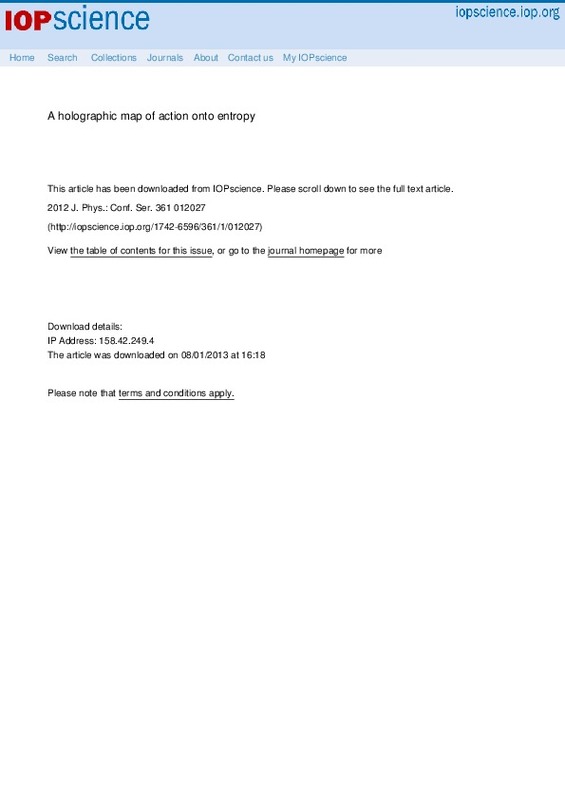JavaScript is disabled for your browser. Some features of this site may not work without it.
Buscar en RiuNet
Listar
Mi cuenta
Estadísticas
Ayuda RiuNet
Admin. UPV
A holographic map of action onto entropy
Mostrar el registro sencillo del ítem
Ficheros en el ítem
| dc.contributor.author | Acosta, D.
|
es_ES |
| dc.contributor.author | Fernández de Córdoba Castellá, Pedro José
|
es_ES |
| dc.contributor.author | Isidro San Juan, José María
|
es_ES |
| dc.contributor.author | González-Santander Martínez, Juan Luis
|
es_ES |
| dc.date.accessioned | 2015-04-28T16:07:09Z | |
| dc.date.available | 2015-04-28T16:07:09Z | |
| dc.date.issued | 2012 | |
| dc.identifier.issn | 1742-6588 | |
| dc.identifier.uri | http://hdl.handle.net/10251/49405 | |
| dc.description.abstract | We propose a holographic correspondence between the action integral I describing the mechanics of a finite number of degrees of freedom in the bulk, and the entropy S of the boundary (a holographic screen) enclosing that same volume. The action integral must be measured in units of (i times) Planck's constant, while the entropy must be measured in units of Boltzmann's constant. In this way we are led to an intriguing relation between the second law of thermodynamics and the uncertainty principle of quantum mechanics. | es_ES |
| dc.language | Inglés | es_ES |
| dc.publisher | IOP Publishing: Conference Series | es_ES |
| dc.relation.ispartof | Journal of Physics: Conference Series | es_ES |
| dc.rights | Reconocimiento (by) | es_ES |
| dc.subject | Action integrals | es_ES |
| dc.subject | Boltzmann's constant | es_ES |
| dc.subject | Finite number | es_ES |
| dc.subject | Holographic screens | es_ES |
| dc.subject | Planck's constants | es_ES |
| dc.subject | Second Law of Thermodynamics | es_ES |
| dc.subject | Uncertainty principles | es_ES |
| dc.subject | Degrees of freedom (mechanics) | es_ES |
| dc.subject | Holography | es_ES |
| dc.subject | Quantum theory | es_ES |
| dc.subject | Thermodynamics | es_ES |
| dc.subject | Entropy | es_ES |
| dc.subject.classification | MATEMATICA APLICADA | es_ES |
| dc.title | A holographic map of action onto entropy | es_ES |
| dc.type | Artículo | es_ES |
| dc.identifier.doi | 10.1088/1742-6596/361/1/012027 | |
| dc.rights.accessRights | Abierto | es_ES |
| dc.contributor.affiliation | Universitat Politècnica de València. Departamento de Matemática Aplicada - Departament de Matemàtica Aplicada | es_ES |
| dc.description.bibliographicCitation | Acosta, D.; Fernández De Córdoba Castellá, PJ.; Isidro San Juan, JM.; González-Santander Martínez, JL. (2012). A holographic map of action onto entropy. Journal of Physics: Conference Series. 361:120271-120279. doi:10.1088/1742-6596/361/1/012027 | es_ES |
| dc.description.accrualMethod | S | es_ES |
| dc.relation.publisherversion | http://dx.doi.org/10.1088/1742-6596/361/1/012027 | es_ES |
| dc.description.upvformatpinicio | 120271 | es_ES |
| dc.description.upvformatpfin | 120279 | es_ES |
| dc.type.version | info:eu-repo/semantics/publishedVersion | es_ES |
| dc.description.volume | 361 | es_ES |
| dc.relation.senia | 232089 | |
| dc.description.references | Adler, S. L. (2004). Quantum Theory as an Emergent Phenomenon. doi:10.1017/cbo9780511535277 | es_ES |
| dc.description.references | Banerjee, R., & Majhi, B. R. (2010). Statistical origin of gravity. Physical Review D, 81(12). doi:10.1103/physrevd.81.124006 | es_ES |
| dc.description.references | BANERJEE, R. (2010). FROM BLACK HOLES TO EMERGENT GRAVITY. International Journal of Modern Physics D, 19(14), 2365-2369. doi:10.1142/s0218271810018475 | es_ES |
| dc.description.references | Blasone, M., Jizba, P., & Vitiello, G. (2001). Dissipation and quantization. Physics Letters A, 287(3-4), 205-210. doi:10.1016/s0375-9601(01)00474-1 | es_ES |
| dc.description.references | Blasone, M., Jizba, P., & Vitiello, G. (2003). Dissipation, Emergent Quantization, and Quantum Fluctuations. Lecture Notes in Physics, 151-163. doi:10.1007/978-3-540-40968-7_12 | es_ES |
| dc.description.references | Carroll, R. (2010). On The Emergence Theme Of Physics. doi:10.1142/9789814291804 | es_ES |
| dc.description.references | ELZE, H.-T. (2009). THE ATTRACTOR AND THE QUANTUM STATES. International Journal of Quantum Information, 07(supp01), 83-96. doi:10.1142/s0219749909004700 | es_ES |
| dc.description.references | Grössing, G. (2009). On the thermodynamic origin of the quantum potential. Physica A: Statistical Mechanics and its Applications, 388(6), 811-823. doi:10.1016/j.physa.2008.11.033 | es_ES |
| dc.description.references | Grössing, G., Mesa Pascasio, J., & Schwabl, H. (2011). A Classical Explanation of Quantization. Foundations of Physics, 41(9), 1437-1453. doi:10.1007/s10701-011-9556-1 | es_ES |
| dc.description.references | Grössing, G. (2010). Sub-Quantum Thermodynamics as a Basis of Emergent Quantum Mechanics. Entropy, 12(9), 1975-2044. doi:10.3390/e12091975 | es_ES |
| dc.description.references | Grössing, G., Fussy, S., Mesa Pascasio, J., & Schwabl, H. (2012). An explanation of interference effects in the double slit experiment: Classical trajectories plus ballistic diffusion caused by zero-point fluctuations. Annals of Physics, 327(2), 421-437. doi:10.1016/j.aop.2011.11.010 | es_ES |
| dc.description.references | Khrennikov, A. (2010). An analogue of the Heisenberg uncertainty relation in prequantum classical field theory. Physica Scripta, 81(6), 065001. doi:10.1088/0031-8949/81/06/065001 | es_ES |
| dc.description.references | Olah, N. (2011). Einsteins trojanisches Pferd. doi:10.1007/978-3-7091-0806-2 | es_ES |
| dc.description.references | Padmanabhan, T. (2011). Lessons from classical gravity about the quantum structure of spacetime. Journal of Physics: Conference Series, 306, 012001. doi:10.1088/1742-6596/306/1/012001 | es_ES |
| dc.description.references | Sakellariadou, M., Stabile, A., & Vitiello, G. (2011). Noncommutative spectral geometry, algebra doubling, and the seeds of quantization. Physical Review D, 84(4). doi:10.1103/physrevd.84.045026 | es_ES |








